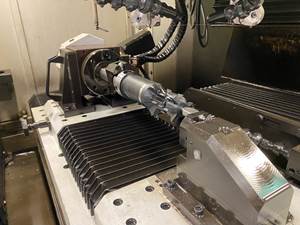Gage Accuracy Runs Hot And Cold
“It takes a while to warm up in the morning, but after that, it runs great. ” I swear that machinists apply this statement to their gages as if the instruments were like car engines with 50-weight motor oil and cold-intake manifolds.
Share



Autodesk, Inc.
Featured Content
View More


Hwacheon Machinery America, Inc.
Featured Content
View More



“It takes a while to warm up in the morning, but after that, it runs great.” I swear that machinists apply this statement to their gages as if the instruments were like car engines with 50-weight motor oil and cold-intake manifolds.
Of course, what’s really happening is the machinist arrives at work; takes the gage and master out of a controlled environment; masters the gage; and then gets to work. As the machinist handles it, the gage begins to warm up. This does not mean the moving parts move more freely, but rather that the gage itself expands. Depending upon where the machinist keeps the master, and whether or not he or she re-masters regularly, the machinist ends up “chasing the reading” until everything reaches equilibrium. This could potentially take hours.
Thermal effects are among the most pervasive sources of gaging error. Dirt, as a gaging problem, is either there or it isn’t. However, everything has a temperature—even properly calibrated gages and masters. The problem arises from the fact that everything else has a temperature too, including the air in the room, the workpiece, the electric lighting overhead and the operator’s fingers. Any one of these “environmental” factors can influence the reading.
Why is temperature such a critical concern? Because most materials expand with heat, and they do so at differing rates. For every 10° F increase in temperature, an inch of steel expands by 0.000060 inch. “Not to worry,” you might say, “I am only working to ‘tenths’.” Aluminum, though, expands at more than twice that rate; tungsten carbide expands at about half the rate. What happens to your reading if you are trying to measure a 2-inch aluminum workpiece with a steel-framed snap gage and tungsten carbide contacts? Now, take into consideration that the workshop has just warmed up by 7 ° F. There are other questions you should ask: “Did the workpiece just come off the machine? How hot is the workpiece?
Only you can answer these questions based on your setup. That’s why it’s critical to keep the gage, the master and the workpiece all at the same temperature.
This means keeping an eye on many factors. Don’t put your master away like some sacred object. Gage and master must be kept together to ensure that they “grow” in tandem and to permit frequent re-mastering. Workpieces must have sufficient time to reach ambient temperature after machining or after being moved from room to room. The operator should handle the gage, master and workpiece only when necessary.
Care must be taken that sources of heat and cold in the room do not intrude on the process. Incandescent lighting; heat and
air conditioner ducts; and even a shaft of direct sunlight through a window can alter a whole series of measurements. Keep things at the same “altitude” in the room to avoid the effects of temperature stratification.
As tolerances tighten, additional measures are necessary. Workpieces should be staged on a heat sink beside the gage and should be handled with forceps or gloves. A Plexiglas shield may be required to protect the gage from the operator’s breath. (The heat, that is, not the effects of the sardine sandwich the operator had for lunch).
For accurate gaging, be aware of possible sources of thermal “contamination” to the measurement process. While it may not be possible to isolate your gaging process in its own perfectly controlled environment, at least take precautions to minimize the effects of temperature variation on your gages, masters and workpieces.
Related Content
Dielectric Oil Dramatically Reduces EDM Maintenance
Plagued by repeated small fires that interrupted its wire EDM throughput, this cutting tool manufacturer changed its dielectric oil and both eliminated fires and reduced its oil consumption.
Read MoreRead Next
Setting Up the Building Blocks for a Digital Factory
Woodward Inc. spent over a year developing an API to connect machines to its digital factory. Caron Engineering’s MiConnect has cut most of this process while also granting the shop greater access to machine information.
Read MoreBuilding Out a Foundation for Student Machinists
Autodesk and Haas have teamed up to produce an introductory course for students that covers the basics of CAD, CAM and CNC while providing them with a portfolio part.
Read MoreRegistration Now Open for the Precision Machining Technology Show (PMTS) 2025
The precision machining industry’s premier event returns to Cleveland, OH, April 1-3.
Read More
















.png;maxWidth=150)






















